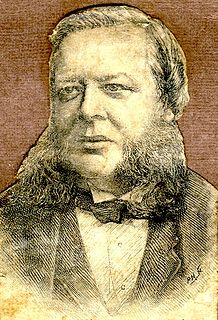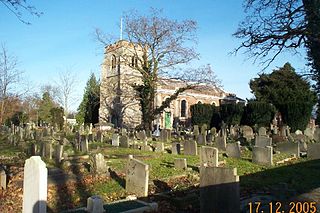
George FridericHandel was a German-born Baroque composer becoming well known for his operas, oratorios, anthems, concerti grossi and organ concertos. Handel received his training in Halle and worked as a composer in Hamburg and Italy before settling in London in 1712, where he spent the bulk of his career and became a naturalised British subject in 1727. He was strongly influenced both by the middle-German polyphonic choral tradition and by composers of the Italian Baroque.

Johann Christoph Pepusch, also known as John Christopher Pepusch and Dr Pepusch, was a German-born composer. He spent most of his working life in England.

Senesino was a celebrated Italian contralto castrato, particularly remembered today for his long collaboration with the composer George Frideric Handel.

Samson is a three-act oratorio by George Frideric Handel, considered one of his finest dramatic works. It is usually performed as an oratorio in concert form, but on occasions has also been staged as an opera. The well-known arias "Let the bright Seraphim", "Total eclipse" and "Let their celestial concerts" are often performed separately in concert.
The year 1718 in music involved some significant events.

James Brydges, 1st Duke of Chandos, was a British landowner and politician who sat in the English and British House of Commons from 1698 until 1714, when he succeeded to the peerage as Baron Chandos, and vacated his seat in the House of Commons to sit in the House of Lords. He was subsequently created Earl of Carnarvon, and then Duke of Chandos in 1719.

John Theophilus Desaguliers FRS was a British natural philosopher, clergyman, engineer and freemason who was elected to the Royal Society in 1714 as experimental assistant to Isaac Newton. He had studied at Oxford and later popularized Newtonian theories and their practical applications in public lectures. Desaguliers's most important patron was James Brydges, 1st Duke of Chandos. As a Freemason, Desaguliers was instrumental in the success of the first Grand Lodge in London in the early 1720s and served as its third Grand Master.

Canons Park is a public park and the name of its surrounding residential area, situated in north west London, in the London borough of Harrow. Canons Park is a former country estate which partially survives today as a public park, historically in what was called the parish of "Little Stanmore". Today the park and its surroundings form the western part of Edgware and is part of its HA8 postal area; it is south and east from the modern definition of Stanmore. St. Lawrence's Church and its accompanying Chandos Mausoleum are located here.

Acis and Galatea is a musical work by George Frideric Handel with an English text by John Gay. The work has been variously described as a serenata, a masque, a pastoral or pastoral opera, a "little opera", an entertainment and by the New Grove Dictionary of Music as an oratorio. The work was originally devised as a one-act masque which premiered in 1718.

Esther is an oratorio by George Frideric Handel. It is generally acknowledged to be the first English oratorio. Handel set a libretto after the Old Testament drama by Jean Racine. The work was originally composed in 1718, but was heavily revised into a full oratorio in 1732.
Chandos Records is a British independent classical music recording company based in Colchester. It was founded in 1979 by Brian Couzens.

Solomon, HWV 67, is an English oratorio by George Frideric Handel. The anonymous libretto – currently thought to have been penned by the English Jewish poet/playwright Moses Mendes (d.1758) – is based on the biblical stories of the wise king Solomon from the First Book of Kings and the Second Book of Chronicles, with additional material from Antiquities of the Jews by ancient historian Flavius Josephus. The music was composed between 5 May and 13 June 1748, and the first performance took place on 17 March 1749, with Caterina Galli in the title role at the Covent Garden Theatre in London, where it had two further performances. Handel revived the work in 1759.

The Harmonious Blacksmith is the popular name of the final movement, Air and variations, of George Frideric Handel's Suite No. 5 in E major, HWV 430, for harpsichord. This instrumental air was one of the first works for harpsichord published by Handel and is made up of four movements. An air is followed by five doubles : semiquavers in the right hand; semiquavers in the left hand; semiquaver triplets in the right and left hands; and finally demisemiquavers in both hands.

Henry Wylde was an English conductor, composer, teacher and music critic.

Cannons was a stately home in Little Stanmore, Middlesex, England. It was built by James Brydges, 1st Duke of Chandos, between 1713 and 1724 at a cost of £200,000, replacing an earlier house on the site. Chandos' house was razed in 1747 and its contents dispersed.

Little Stanmore was an ancient parish of Middlesex which is today the residential area of Canons Park in the London Borough of Harrow, England.
As pants the hart is an anthem composed by George Frideric Handel for the Chapel Royal of Queen Anne and subsequently revised. There are five versions of the work, the first being completed in 1713, and the final in 1738. HWV 251a was the first anthem Handel composed for the Chapel Royal.

Chandos Jubilate, HWV246, is a common name for a choral composition by George Frideric Handel. It was published as the first of the Chandos Anthems, and is known also as Chandos Anthem No. 1 and as Jubilate in D Major. A setting of Psalm 100, "O, be joyful in the Lord", it is the first in a series of church anthems that Handel composed between 1717 and 1718, when he was composer in residence to James Brydges, later 1st Duke of Chandos. The anthem was probably first performed at St. Lawrence's church, Whitchurch, near Brydges' country house. The work is written for a small ensemble of instrumentalists, solo singers and choir, and is approximately twenty minutes in length.

St. Lawrence, Whitchurch, is a Church of England parish church in Little Stanmore in the London Borough of Harrow, England. The building is Grade I listed. It retains a stone tower dating from ca. 1360, but the main body of the building was constructed in the 18th century in Baroque style.

Chandos Anthems, HWV 246–256, is the common name of a collection of eleven anthems, sacred choral compositions written by George Frideric Handel, with the authorship of No. 12 being debated. The texts are psalms and combined psalm verses in English. Handel wrote the anthems as composer in residence at Cannons, the court of James Brydges, who became the First Duke of Chandos in 1719. His chapel was not yet finished, and services were therefore held at St Lawrence in Whitchurch. The scoring is intimate, in keeping with the possibilities there. Some of the anthems rely on earlier works, and some were later revised for other purposes.













